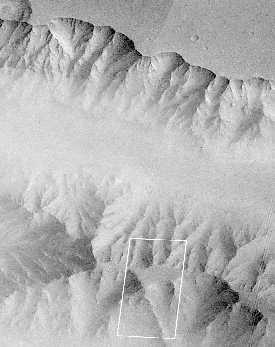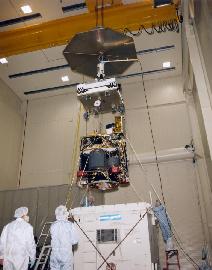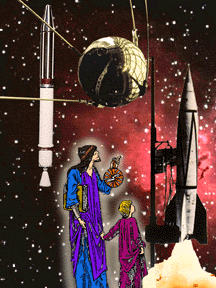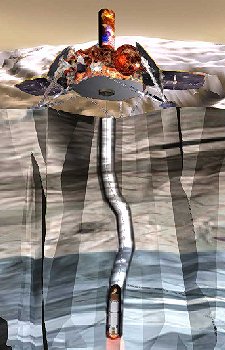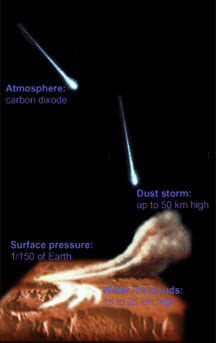Missions to Mars
| Mission | Country | Launch Date | Arrival Date | Type | Mission Highlights |
|---|---|---|---|---|---|
| Mars 1960A | USSR | October 10, 1960 | ---- | Flyby | Failed to reach Earth orbit |
| Mars 1960B | USSR | October 14, 1960 | ---- | Flyby | Failed to reach Earth orbit |
| Mars 1962A (Sputnik 22) | USSR | October 24, 1962 | ---- | Flyby | Was to flyby Mars, but it broke into pieces right after launch. Pieces remained in Earth orbit for a few days before falling back through Earth's atmosphere. |
| Mars 1 | USSR | November 1, 1962 | ---- | Flyby | Communications failed enroute. As of March 21, 1963, the spacecraft was never heard from again. At this point, the spacecraft was 106,760,000 km from Earth. |
| Mars 1962B (Sputnik 24) | USSR | November 4, 1962 | ---- | Lander | Mars 1962B was designed to land on Mars. The spacecraft and booster system designed to transfer Mars 1962B to Mars trajectory broke up during that transfer. Pieces fell through the Earth's atmosphere in January 1963. |
| Mariner 3 | USA | November 5, 1964 | ---- | Flyby | After launch from Earth, a protective shield failed to eject. This left all of the sensors covered. The extra weight of the shield prevented the spacecraft attaining its Mars trajectory. |
| Mariner 4 | USA | November 28, 1964 | July 14, 1965 | Flyby | First successful flyby of the planet Mars. Returned first pictures of Martian surface. Closest approach: 9912 km Returned: 22 images |
| Zond 2 | USSR | November 30, 1964 | ---- | Flyby | Zond 2 carried same instruments as Mars 1. Again, communications failed enroute. |
| Mariner 6 | USA | February 24, 1969 | July 31, 1969 | Flyby | Mariner 6 and 7 were identical spacecraft sent to flyby Mars, collecting data about the surface and atmosphere of Mars. Closest approach: 3330 km Returned: 75 images |
| Mariner 7 | USA | March 27, 1969 | August 5, 1969 | Flyby | Mariner 6 and 7 also collected data relevant to the search for life on Mars. Closest approach: 3518 km Returned: 126 images |
| Mars 1969A | USSR | March 27, 1969 | ---- | Orbiter | Launch complications. Orbiter actually exploded seconds after launch and pieces fell into the Altai mountains. |
| Mars 1969B | USSR | April 2, 1969 | ---- | Orbiter | Launch complications. One of the rocket stages exploded. This mission was an identical orbiter to Mars 1969A. Unfortunately, neither made it into orbit. |
| Mariner 8 | USA | May 8, 1971 | ---- | Flyby | Failed to reach orbit. The booster Mariner was attached to failed, causing the spacecraft to fall back through the Earth's atmosphere about 560 km north of Puerto Rico. |
| Kosmos 419 | USSR | May 10, 1971 | ---- | Orbiter | Failed to leave Earth orbit. Booster stage failed so orbit decayed and Kosmos 419 re-entered the Earth's atmosphere on May 12, 1971. |
| Mars 2 | USSR | May 19, 1971 | November 27, 1971 | Orbiter | Returned data until 1972 about Martian atmosphere, surface, gravity, magnetosphere and temperature. |
| Lander | Crash landed on surface due to failure in braking rockets. Was not able to transmit any data. | ||||
| Mars 3 | USSR | May 28, 1971 | December 2, 1971 | Orbiter | Mars 2 and 3 were able to send back 60 images of Mars. |
| Lander | Did achieve soft landing on Mars, but instruments stopped working after 20 seconds. It is thought that there was a huge dust strom at the time of landing that caused instrument failure. | ||||
| Mariner 9 | USA | May 30, 1971 | November 13, 1971 | Orbiter | Mariner 9 returned more than 7,329 images. These images provided the first global mapping of Mars. Mariner 9 also included the first detailed views of moons Phobos and Deimos. |
| Mars 4 | USSR | July 21, 1973 | February 1974 | Orbiter | Was suppose to go into orbit around Mars, but due to computer chip failure, the spacecraft could not slow down. It flew past Mars at 2,200 km range and was able to return one swath of images and data on the ionosphere of Mars. |
| Mars 5 | USSR | July 25, 1973 | February 2, 1974 | Orbiter | Mars 5 successfully entered Mars orbit. Over 60 images were returned in 9 day period. Then, there was a loss of pressurization failure and the spacecraft could not submit more data. Unfortunately, Mars 5 was suppose to serve as relay transmitters for landers 6 and 7. |
| Mars 6 | USSR | August 5, 1973 | March 12, 1974 | Lander | Soft landed at 24* S, 25* W Returned atmospheric data to carrier bus during descent, but not after landing. |
| Mars 7 | USSR | August 9, 1973 | March 6, 1974 | Lander | Due to computer chip failures, the Lander missed the planet. Carrier bus and lander now in solar orbit. |
| Viking 1 | USA | August 20, 1975 | July 20, 1976 | Lander and Orbiter | The Viking Landers obtained images, measured wind speeds, wind directions, and temperatures at the surface. They also measured chemical and physical properties of the surface. In all, the 2 Landers returned over 1,400 images of their landing sites. |
| Viking 2 | USA | September 9, 1975 | September 3, 1976 | Lander and Orbiter | The Viking 1 and 2 Orbiters returned 55,000 images showing surface details as small as 10 m. They also collected gravity field data, monitored atmospheric water levels, and thermally mapped selected surface sites. |
| Phobos 1 | USSR | July 7, 1988 | ---- | Lander and Orbiter | Lost en route to Mars due to command error on September 2, 1988. After this contact could not be regained. |
| Phobos 2 | USSR | July 12, 1988 | January 1989 | Landers and Orbiter | Phobos 2 went into orbit around Mars. It did gather data on the Sun, interplanetary medium, Phobos and Mars. A malfunction of the on-board computer caused Earth to lose contact with Phobos 2, so that commands could not be given to release the 2 Landers to the Martian surface. |
| Mars Observer | USA | September 25, 1992 | August 1993 | Orbiter | Contact with the Mars Observer was lost on August 21, 1993, just 3 days before scheduled orbit insertion. Reasons for lost contact were never established. |
| Mars Global Surveyor | USA | November 7, 1996 | September 11, 1997 | Orbiter | The MGS is a kind of replacement for the lost Mars Observer. It has the same spacecraft design. Its science objectives are to complete a high resolution mapping of the surface, study the topography and gravity of Mars, assess the role of water and dust on the surface and in the atmosphere of Mars, and determine the existence and evolution of the Martian magnetic field. The mission is expected to continue until April of 2002. |
| Mars 96 | Russia | November 16, 1996 | ---- | Orbiter | The spacecraft failed to achieve Mars trajectory. It crashed back through the Earth's atmosphere on November 17, 1996, landing in the Pacific Ocean. |
| Mars Pathfinder | USA | December 4, 1996 | July 4, 1997 | Lander | The MPF landed on Martian surface on July 4, 1997. The Sojourner rover rolled onto the surface on July 6, 1997. The rover explored the surface and analyzed rock and soil samples. The stationary component was powered by solar panels. |
| Nozomi (Planet B) | Japan | July 3, 1998 | December 2003 | Orbiter | The Nozomi spacecraft has been delayed four years from its original scheduled rendezvous with Mars in 1999. It will reach Mars in 2003. It will proceed to study the upper atmosphere of Mars and its interaction with the solar wind. Nozomi means "hope" in Japanese. |
| Mars Pathfinder | USA | December 4, 1996 | July 4, 1997 | Lander | The MPF landed on Martian surface on July 4, 1997. The Sojourner rover rolled onto the surface on July 6, 1997. The rover explored the surface and analyzed rock and soil samples. The stationary component was powered by solar panels. |
| Mars Climate Orbiter(Mars '98 Orbiter) | USA | December 11, 1998 | ---- | Orbiter | The MCO made it to Mars, but was torn apart by atmospheric stresses when faulty commands were sent to the spacecraft bringing the spacecraft too close to the surface of the planet. This navigation error resulted because come commands were sent using English units when they should have been sent in metric units! This shows the importance of checking your work several times and having your work evaluated and checked by others! |
| Mars Polar Lander (Mars Surveyor '98 Lander) | USA | January 3, 1999 | ---- | Lander | The Mars Polar Lander was suppose to touch down in the southern polar region of Mars. Unfortunately, contact with the spacecraft was lost on December 3, 1999. The spacecraft has not been heard from again and no reason for the loss of signal is known. |
| Deep Space 2 (Mars Microprobes) | USA | January 3, 1999 | ---- | Surface penetrators | These Deep Space 2 probes were attached to the Mars Polar Lander. The probes were released and were suppose to penetrate the Martian atmosphere and the Martian surface in the south polar region. One of the most important pieces of data these 2 probes were to return was whether there is water ice below the surface of Mars. Unfortunately, on December 3, 1999, contact with the probes was lost. |
| 2001 Mars Odyssey | USA | April 7, 2001 | October 24, 2001 | Orbiter | The 2001 Odyssey will orbit Mars for at least 3 years. The 2001 Odyssey will collect data on what chemicals and minerals make up the Martian surface. It will also provide vital information about potential radiation hazards for future human explorers. |
| Mars Express | European Space Agency | June 2, 2003 | December 25, 2003 | Orbiter and Lander | The orbiter is mapping the Martian surface, searching for subsurface water, and studying Martian geology and the atmosphere. The lander, named Beagle 2, was lost during landing. |
| Mars Exploration Rovers | USA | June 10 & July 7, 2003 | January 4 & January 25, 2004 | Twin Landers | These twin rovers have been exploring the Martian surface for more than 4 years (as of May 2008), far beyond their initial target mission duration of 90 days! |
| Mars Reconnaissance Orbiter | USA | August 12, 2005 | March 10, 2006 | Orbiter | MRO is making high resolution maps of the Martian surface, partly to help with selection of future landing sites for upcoming missions |
| Phoenix Mars Lander | USA | August 4, 2007 | May 25, 2008 | Lander | Phoenix will land near the Martian North Pole. It will search for water ice, and will scoop up soil samples with its robotic arm and analyze them in onboard laboratories. |
 An Overview of Space Exploration
An Overview of Space Exploration
Last modified May 20, 2008 by Randy Russell.







